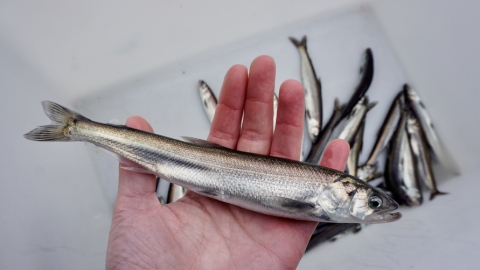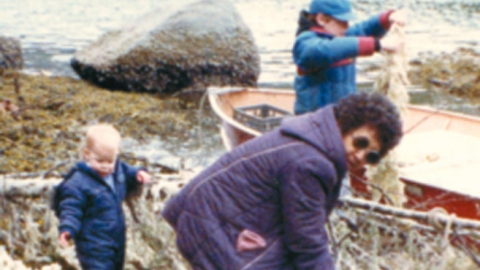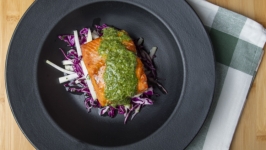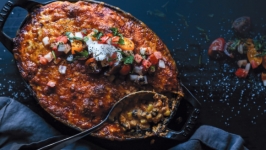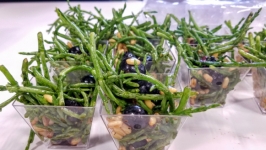Welcoming the Saak and the spirit of Spring
Each spring, schools of small silvery fish migrate from the depths of the Pacific Ocean towards land in search of freshwater to spawn. Celebrated by coastal Indigenous peoples from northern California to Southwest Alaska, this fish has many names, including ooligan, oolichan, and hooligan.
Also called “candlefish,” about 20 percent of their bodyweight is oil. When dried, they burn slow and steady like a candle. Rendering the oil creates a stable, soft golden-yellow grease with a buttery texture rich in healthy fatty acids and vitamins E and K. Traditional food preservation methods include submerging berries, meats, and plants in this grease for winter storage.
A caloric and nutritional lifeline for northern peoples, hooligan oil was once so highly valued that an extensive network of traditional trade routes known as “grease trails” crisscrossed mountain passes to connect coastal and inland peoples. Some of the wealthiest traders were the Chilkoot and Chilkat Tlingit peoples at the northern end of a deep long fjord now called Lynn Canal in Southeast Alaska. Their traditional territories include the areas around Haines, Skagway, and further north beyond the Canadian border. “Deishu means ‘end of the trail, start of the trail’” explained James Gooch éesh Hart, whose family is from Deishu, the original Lingít place name for where Haines is today.
“The time when the saak return is a special and happy time. It’s life coming back to the valley.”
Saak is the Lingít name for these fish. Both the Chilkat and Chilkoot Rivers are part of an extensive system of pristine rivers that descend from glaciers on the Coast Range near the Canadian border. The silty glacial waters of the Chilkat River flow from the valley that extends between the snowcapped Chilkat Range to the west and the Takshanuk Mountains to the east. Further south in the valley, the crystal-clear Chilkoot River flows from Chilkoot Lake into the canal. These intact watersheds are among a few of the places in the world where saak continue to return, nourishing people, wildlife, and forest ecosystems since time immemorial.
After traveling upriver from the ocean, saak gather at the upper end of Lynn Canal in brackish estuaries where saltwater meets freshwater. When ready, a small group of scouts swims ahead of the big schools to check on the rivers. If all is well, the rest of the run follow and choose which rivers to enter. The saak also travel up other river systems in upper Lynn Canal.
“The time when the saak return is a special and happy time,” affirmed Gooch Eesh. “It’s life coming back to the valley.” Springtime is the season of awakening from the deep sleep of winter. Both people and animals are in a state of energetic depletion. Gradually, darkness and cold dissolve into the brightness of rapidly expanding daylight. Then, a multi-species feeding frenzy announces the arrival of the saak, filling the sky with flocks of birds. Marine mammals emerge from the sea in a cacophony of sound and motion.
“You see the sea lions feeding on them, chasing them around. Then the humpback whales and the killer whales start feasting. And then us humans start feasting!” said Sonny Williams, a lifelong fisherman in Deishu from the Lukaax.ádi sockeye clan, with a laugh. “I’ve been catching hooligans ever since I was young enough to get a dipnet and get them out.”
Also known as “salvation fish,” they arrive just in time when fresh food is scarce and stored food supplies are low. “It’s before the salmon arrive,” explained Ted Aaktaatseen Hart of Deishu who has dedicated his life to learning from the saak and continues to uphold his Tlingit ancestors’ relationship with these fish. “That can be a make-or-break time. To get that huge bump of nutrients is essential.”
Monitoring abundance
Saak is a small fish in the smelt family and measures 4 to 8 inches in length with shimmering silver and blue scales. Fish of different sizes and ages all swim together. When a run is strong, the water can be so packed with fish that it appears black.
Known as eulachon by biologists, the scientific name is Thaleichthys pacificus. While they once ranged from the coast of northern California to Southwest Alaska, the distinct southern populations in Washington, Oregon, California, and parts of British Columbia have dwindled so much that the runs are classified as threatened, endangered, or even extinct. Eulachon runs in other parts of Southeast Alaska have also declined. The river systems of upper Lynn Canal are among the few in North America still strong enough to support subsistence fishing.
For over 13 years, Chilkoot Indian Association (CIA) has led an ongoing study to monitor saak populations in the Chilkoot River. Community members including Williams advocated for learning more about the saak in the area. “CIA started the program because we were concerned about population decline. The elders have been saying they’re seeing less,” said Aaktaatseen. Today the program has expanded to monitor nine rivers that flow into Lynn Canal.
CIA’s partners include Takshanuk Watershed Council (TWC), Skagway Traditional Council (STC), and Oregon State University (OSU). A strength of the program is the partnership between tribal members, elders, scientists, and field technicians who work together in a way that values Indigenous science and traditional ecological knowledge alongside Western science. These baseline population estimates over time will increase understanding of abundance and help guide stewardship and protection of this keystone species that supports the valley’s rich biodiversity and cultural heritage. The program has also inspired other Alaska Native and First Nations communities to start similar eulachon population monitoring studies.
Welcoming the saak and respectful harvesting
Community members of the Chilkat Valley share the wisdom of their ancestors so everyone can continue to welcome the saak in a good way.
Wait and allow the scouts to pass.
“The first that arrive are the scouts. They clean up the beds, make sure it’s safe. They look for the best route for the huge mass of fish that’s behind them. If the scouts show up and it’s not ideal, they’ll turn and go elsewhere,” shared Aaktaatseen. “It’s very important that they’re greeted well, and that a certain amount go up to the spawning areas first, before any nets are put in the water, before any fishing happens. Give them a day or two. When the bigger run follows, then fishing can commence. Everyone will have more than enough. Have patience, let them get established, and then you’ll have a big harvest that year.”
Saak are sensitive, so avoid disturbing them.
An uninterrupted run allows for others to have a chance to harvest, so use dipnets instead of throw nets. Dipnets are the least disruptive method to catch reasonable amounts. Throw nets are weighted nets meant for fishing in a different ecosystem and are inappropriate for harvesting saak on the Chilkoot River because they scare the fish and can also lead to overharvesting and waste.
Don’t let dogs go in the water.
Similarly, the smell and the disturbance of a dog in the water stress the saak and can cause them to retreat downriver. Leave dogs at home or keep them in the car during the harvest.
Teach children to respect the saak.
Teach children to respect the saak by not throwing rocks and other things that could scare them. Instead, share stories and involve them in activities such as observing them from shore, fishing, and helping prepare and process saak for winter.
Learning from the saak
The river systems of the Chilkat Valley host all five species of salmon and also attract one of the largest convergences of bald eagles in the world. While many locals and visitors are familiar with fishing for salmon, there are clear distinctions between salmon and eulachon. “Unlike salmon that die in the river after spawning, we observe eulachon moving back into the estuary after spawning,” shared Meredith Pochardt, a fisheries biologist in Deishu who supports the CIA monitoring project.
Derek Poinsette, Executive Director of Takshanuk Watershed Council, explained another distinction. “Salmon return to their natal stream, where they are born. If the hooligan show up to a river and the conditions aren’t to their liking, they may just go and spawn in another river near by. Alternatively, if they find good conditions elsewhere, they may not even bother checking in on their natal stream.”
Traditional ecological knowledge recognizes that saak are sensitive to noise and disturbance. Traditional stewardship includes greeting them with peaceful behavior and practices in order to encourage a longer run in rivers accessible to the community. Diminishing runs of hooligan in the Lower 48 are thought to be due to industrial activities, pollution, and high shipping traffic.
While the rivers of the Chilkat Valley continue to receive saak runs, the length of runs can range from a few days to a few weeks. “Some years they do not show up at all. I’ve seen a couple no-shows on the Chilkoot. That’s detrimental to us,” said Aaktaatseen.
Throughout the years of the monitoring project, community members and scientists in Deishu, Chilkat Valley, and in nearby Skagway have observed eulachon divert their spawning location due to sound disturbances like pile driving and blasting. Many are concerned that increased industrial activities in the Chilkat Valley could threaten saak runs along with the rest of the ecosystem that depends on them.
Rendered, smoked, dried, fried, and more
Traditionally, making ooligan grease involves fermenting the fish for many days prior to several rounds of cooking, stirring, skimming, and filtering. In Klukwan, a village located on the banks of the Chilkat River, Katrina Aklá Hotch shared that the key to good oil is to heat it at a low enough temperature that it does not boil and carefully skimming the oil to avoid collecting sediments. “It’s a big family production,” she said. “It could be long days of work but it’s all shared work.” After the oil has been separated out for grease, the softened fermented fish that remains is a delicious treat.
“It takes a lot of commitment and good intentions,” said Aaktaatseen. The finished oil is described as an “acquired taste” ranging from strong and fishy to mild. He likes to dip seaweed or dried salmon in it. “It’s also good in soup—gives it a rich flavor and thickens it up.”
Other contemporary methods of preparation include pan frying, breading and frying, smoking and jarring, drying, and pickling.
Individuals and families have their own unique ways of smoking and drying saak. Sonny Williams remembers how his step-grandmother showed him how to pick out the males and fillet them. “The male has a ridge on both sides of the upper part of the back. The female is smooth and shiny.”
Now an elder himself, Williams still takes the time to separate them, only harvesting males, and returning females to the river. Over the years, Williams customized what he learned from his elders and adapted the process to fit his own preferences by cutting out the backbone before drying and smoking them. Others keep their saak whole or in halves. Some smoke their fish for hours like him while others keep the smoke going for days. “Everyone has their preference.”
Saak season is a season of joy and rekindling relationships. “It’s a time for people to gather after a long, dark winter. The saak are a light being. They’re sensitive. They don’t like any kind of drama,” shared Aaktaatseen. “It’s a time when people put away old grievances, strengthen those bonds, and work together.” Harvesting with gratitude, happiness, and respect is a way to thank them for bringing light and life back to the world.










